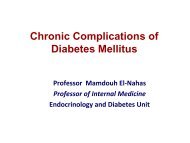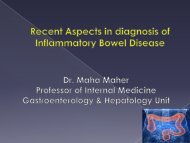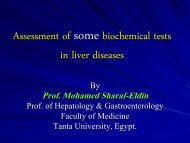Diagnosis of intestinal parasitic infections
Diagnosis of intestinal parasitic infections
Diagnosis of intestinal parasitic infections
You also want an ePaper? Increase the reach of your titles
YUMPU automatically turns print PDFs into web optimized ePapers that Google loves.
Recent Diagnostic<br />
Methods for<br />
Intestinal Parasitic<br />
Infections<br />
By<br />
Dr. Doaa Abdel Badie Salem<br />
Lecturer <strong>of</strong> Medical<br />
Parasitology, Mansoura<br />
Faculty <strong>of</strong> Medicine
Agenda<br />
• Intestinal parasites.<br />
• Traditional Diagnostic<br />
Methods.<br />
• Why we are looking for<br />
new techniques for<br />
diagnosis <strong>of</strong> <strong>intestinal</strong><br />
<strong>parasitic</strong> tract?<br />
• Commercially available<br />
techniques<br />
• Hoping future techniques<br />
5/26/2012 • Summary<br />
3
Most common Egyptian <strong>intestinal</strong> parasites<br />
Protozoa<br />
Helminthes<br />
Entamoeba<br />
histolytica<br />
Trematodes Cectodes Nematodes<br />
Coccidea<br />
(Cryptosporidium<br />
parvum, Isospora<br />
belli, Cyclospora<br />
cayetanensis)<br />
Schistosoma<br />
mansoni<br />
Teania spp. ( T.<br />
saginata and T.<br />
solium )<br />
Strongoiloides<br />
stercoralis<br />
Giardia duodenalis<br />
Hetrophyes<br />
hetrophyes<br />
Hymenolipes ( H.<br />
nana and H.<br />
diminuta).<br />
Soil transmitted<br />
helminths STH<br />
(Ascaris lumbricoid,<br />
Trichuris<br />
trichiura, Hook<br />
worm)<br />
Enterobius<br />
vermicularis<br />
5/26/2012 5
Entamoeba histolytica<br />
Giardia duodenalis<br />
Hetrophyes hetrophyes,<br />
Teania spp., Hymenolipes spp.<br />
STH, Strongoiloides stercoralis<br />
Enterobius vermicularis<br />
5/26/2012 6
Mode <strong>of</strong> transmission<br />
• IPIs are linked to lack <strong>of</strong> sanitation, lack <strong>of</strong><br />
access to safe water and improper hygiene.<br />
• Protozoan mainly transmitted by feco-oral (auto<br />
infection, person to person, food, water,….).<br />
• Intestinal trematodes by fish eating, and skin<br />
penetration.<br />
• Intestinal cectodes by ingestion <strong>of</strong> meat<br />
auto infection, insect ingestion.<br />
• Intestinal nematodes by ingestion <strong>of</strong><br />
contaminated food, autoinfection, skin<br />
penetration<br />
5/26/2012 7
<strong>Diagnosis</strong> <strong>of</strong> <strong>intestinal</strong><br />
<strong>parasitic</strong> <strong>infections</strong><br />
CLINICAL<br />
PICTUR<br />
LABORATORY<br />
5/26/2012 8
Clinical picture<br />
• Diarrhea<br />
• Dysentery<br />
• Anemia<br />
• Allergy<br />
• Constipation<br />
• Acute abdomen<br />
• Peri-anal itching<br />
• Bloating, dyspepsia<br />
5/26/2012 9
I-Traditional Diagnostic Methods<br />
5/26/2012 10
Searching for:<br />
1-Macroscopic stool<br />
• 1- Blood and mucus.<br />
examination<br />
• 2-Some adult helminths as Ascaris<br />
lumbricoid or segments as Tenia spp. or<br />
Hymenolips spp.<br />
5/26/2012 11
2-Microscopic stool examination.<br />
Relies on the detection <strong>of</strong><br />
• Trophozoites<br />
• Cysts<br />
• Eggs<br />
• Larvae<br />
5/26/2012 12
• How to improve the sensitivity <strong>of</strong><br />
microscopic examination?<br />
- Multiple stool specimens.<br />
- Concentration procedures.<br />
- Variety <strong>of</strong> staining methods, are needed<br />
to achieve ample sensitivity for <strong>intestinal</strong><br />
coccidean as<br />
- Modified ZN stain, non specific<br />
fluorescent stain, and some have the<br />
ability for auto fluorescence.<br />
5/26/2012 13
Entamoeba<br />
cyst<br />
trophozoite<br />
5/26/2012 14
Giardia <strong>intestinal</strong>is<br />
5/26/2012 15
Intestinal coccidean<br />
5/26/2012 16
Auto fluorescence<br />
Isospora belli<br />
Non specific<br />
fluorescent stain for<br />
Cryptosporidium<br />
5/26/2012 17
Some <strong>intestinal</strong> helminths eggs<br />
5/26/2012 18
Some cectode eggs<br />
5/26/2012 19
Some trematodes eggs<br />
5/26/2012 20
3- Antibody-detection assays<br />
1- CFT<br />
2- IHA<br />
3-ELISA<br />
5/26/2012 21
Why we are searching for new<br />
methods for diagnosis <strong>of</strong><br />
<strong>intestinal</strong> <strong>parasitic</strong> <strong>infections</strong>?<br />
5/26/2012 22
• Although microscopy is considered to<br />
be the gold standard,<br />
-It is labour-intensive<br />
-Its diagnostic performance critically depends<br />
on well-trained microscopists.<br />
-It is not sensitive and may result in<br />
misdiagnosis leading to delayed or<br />
inadequate treatment.<br />
-<br />
5/26/2012 23
- <strong>Diagnosis</strong> <strong>of</strong> E. histolytica cannot be done<br />
any longer by microscopy, since this<br />
parasite is morphologically similar to the<br />
non-pathogenic parasite E. dispar.<br />
- Increase prevalence <strong>of</strong> immune<br />
compromised sectors in our locality<br />
(chronic liver disease, CKD, DM,<br />
malignancy…….).<br />
- Empirical treatment is not preferable<br />
5/26/2012 24
Limitations for Ab detection:<br />
1- Some <strong>intestinal</strong> parasites do not have<br />
commercially or FDA approved antibody<br />
detection tests for their diagnosis.<br />
2-Experimental results have been too<br />
variable due to the type <strong>of</strong> antigen<br />
preparations used (e.g., crude,<br />
recombinant purified, adult worm, egg)<br />
and also because <strong>of</strong> the use <strong>of</strong> non<br />
standardized test procedures.<br />
5/26/2012 25
• 3- Cross-reaction leading to false-positives<br />
and misdiagnosis, especially in regions<br />
where more than one parasite is endemic.<br />
(cross-reactivity exists between filarial and<br />
other helminth antigens).<br />
• 4- Inability <strong>of</strong> antibody-detection tests to<br />
differentiate between past and currently<br />
active <strong>infections</strong><br />
5/26/2012 26
Commercially available techniques<br />
5/26/2012 27
5/26/2012 28
• Immunology-based diagnosis tools can<br />
be divided into two categories:<br />
1-Antigen-detection assays<br />
2- Antibody-detection assays.<br />
5/26/2012 29
• ELISA and direct fluorescent antibody assays<br />
have been accepted as cost-effective alternative<br />
diagnostic methods for the detection <strong>of</strong> G.<br />
lamblia and Cryptosporidium in stools.<br />
5/26/2012 30
Coproantigen ELISA:<br />
• Principle:<br />
The various components involved in<br />
ELISA are a solid phase to which<br />
specific antibody is coated, an<br />
antibody enzyme conjugate as probe<br />
and enzyme substrate. Solid supports<br />
used are polystyrene or PVC<br />
microtitre plates<br />
5/26/2012 31
5/26/2012 32
Applications:<br />
• For Strongyloides<br />
• Cryptosporidium<br />
• Giardia<br />
• E. histolytica<br />
5/26/2012 33
Disadvantage<br />
• Requires multiple reagent additions<br />
• Washing steps.<br />
• Incubations.<br />
Advantages<br />
(i) Numerous samples can be screened at<br />
one time.<br />
(ii) Tests can be read objectively on a<br />
spectrophotometer instead <strong>of</strong> subject.<br />
5/26/2012 34
Direct fluoresce antibodies (DFA)<br />
Principle:<br />
• Utilize fluorescein-labeled antibodies<br />
directed against cell wall antigens <strong>of</strong><br />
Giardia cysts and Cryptosporidium oocysts<br />
5/26/2012 35
5/26/2012 36
5/26/2012 37
Advantage <strong>of</strong> DFA:<br />
• Allow visualization <strong>of</strong> the intact parasites,<br />
providing a definitive diagnosis<br />
Disadvantage <strong>of</strong> DFA<br />
• Requires fluorescence microscopy<br />
5/26/2012 38
Immunecromatographic assay<br />
Principle:<br />
It is the same as ELISA, but differs only in<br />
that the immunological reaction carried out<br />
on cromatographic paper by capillary action.<br />
5/26/2012 39
• Two kinds <strong>of</strong> specific Ab :<br />
-one <strong>of</strong> the Ab (immoblised on clear<br />
defined line (test line)<br />
-the 2 nd labled with detection agent as<br />
colloidal gold and infiltrated in<br />
congugated pad<br />
• The Ag to be detected or anti Ab<br />
deposited on the same strip in<br />
another line (control line)<br />
5/26/2012 40
Cromatographic paper structure<br />
5/26/2012 41
5/26/2012 42
Applications<br />
• -Hymenolipes<br />
• -Cryptosporidium and Girdia<br />
• -E. hisolytica<br />
• -Urine-CCA (Circulating Cathodic<br />
Antigen) for Schistosoma mansoni.<br />
5/26/2012 43
Forms <strong>of</strong> immunchromatography tests<br />
5/26/2012 44
5/26/2012 45
5/26/2012 46
ImmunoCard STAT! Cryptosporidium/Giardia Rapid Assay (Meridian Bioscience, Inc.).<br />
Garcia L S et al. J. Clin. Microbiol. 2003;41:209-212
Garcia L S et al. J. Clin. Microbiol. 2000;38:3337-3340<br />
parasite panel demonstrating positive results.
Advantage<br />
• Rapid<br />
• Stable at temperatures up to 40°C,<br />
• Easy to use,<br />
• Cost-effective<br />
Disadvantage<br />
• They are useless at detecting very lowdensity<br />
<strong>infections</strong>.<br />
5/26/2012 49
Hoping future techniques<br />
5/26/2012 50
1-Flowcytometry<br />
5/26/2012 51
5/26/2012 53
Cryptosporidium in stool<br />
FSC (x-axis) versus SSC (yaxis).<br />
The scatter-plots for Cryptosporidium oocysts<br />
representing FSC vs SSC<br />
(a): The scatter-plot for oocysts without staining.<br />
(b): The scatter-plot for oocysts stained with<br />
direct immun<strong>of</strong>luorescent antibody
2- Molecular<br />
Based<br />
Approaches<br />
5/26/2012 55
A-Conventional PCR<br />
Four basic components:<br />
• A DNA template .<br />
• Primers<br />
• A heat-stable DNA-polymerase enzyme -<br />
• Free nucleotides<br />
5/26/2012 56
5/26/2012 57
5/26/2012 58
Disadvantage <strong>of</strong> PCR<br />
• The introduction <strong>of</strong> these methods in daily<br />
laboratory practice is still uncommon<br />
especially in rural endemic regions.<br />
• PCR-based methods also suffer by the<br />
lack <strong>of</strong> standardization. DNA extraction,<br />
choice <strong>of</strong> primer sets, and use <strong>of</strong> various<br />
amplification protocols are all factors that<br />
may cause this diversification in results<br />
5/26/2012 59
Advantage<br />
• DNA-based methods have shown excellent<br />
sensitivity and specificity<br />
5/26/2012 60
B-Real-time PCR (RT-PCR)<br />
• Principle:<br />
This method utilizes an additional primer,<br />
the probe, which also binds specifically to<br />
the target DNA sequence. Probes have a<br />
fluorescent 'reporter' dye at one end and a<br />
'quencher' dye, which inhibits fluorescence,<br />
at the other. During the extension stage the<br />
probe is broken apart by the DNApolymerase<br />
and begins to fluoresce more<br />
strongly.<br />
5/26/2012 61
• The fluorescence can be measured at<br />
each cycle and increases in proportion to<br />
the number <strong>of</strong> target sequence copies<br />
produced. This means that the assay can<br />
be made quantitative by recording the<br />
cycle at which the fluorescence intensity<br />
rises above the background level for<br />
each test sample and for a set <strong>of</strong><br />
standards run at the same time. A<br />
standard curve can then be drawn and<br />
the amount <strong>of</strong> target DNA present in the<br />
sample can be calculated from the<br />
standard curve.<br />
5/26/2012 62
5/26/2012 63
Advantage<br />
• Quantitation.<br />
• This eliminates gel electrophoresis thereby<br />
greatly reducing the risk <strong>of</strong> contamination<br />
and the introduction <strong>of</strong> false-positives<br />
5/26/2012 64
Disadvantage<br />
• It requires expensive equipment.<br />
• Specialized personnel for analysis <strong>of</strong> the<br />
results<br />
5/26/2012 65
C-loop-mediated isothermal<br />
amplification (LAMP)<br />
• Principle:<br />
- The target sequence is amplified at a<br />
constant temperature <strong>of</strong> 60 - 65 °C using 4<br />
sets <strong>of</strong> primers and a polymerase.<br />
- Amplification results in visible turbidity due<br />
to precipitation, which allows easy<br />
visualization by the naked eye,<br />
5/26/2012 66
Advantage<br />
• Results in higher yields<br />
• Eliminates the need to buy a thermal cycler<br />
• Shortens the reaction time by eliminating<br />
time lost during thermal changes.<br />
The future adoption <strong>of</strong> LAMP as<br />
a diagnostic tool for parasite<br />
<strong>infections</strong> in rural endemic<br />
regions shows promise<br />
5/26/2012 67
Application :<br />
E. histolytica<br />
G. lamblia<br />
Cryptosporidium<br />
Schistosoma mansoni<br />
5/26/2012 68
5/26/2012 69
5/26/2012 70
5/26/2012 72









